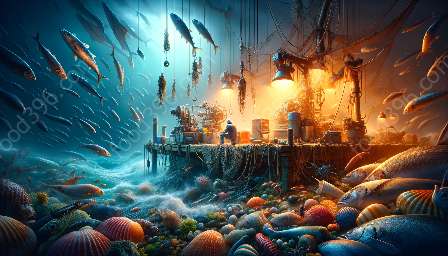Fishing nets are a crucial component of the fishing industry, allowing fishermen to catch fish and other aquatic species efficiently. There are various types of fishing nets designed for different purposes, each with its unique features and applications. In this comprehensive guide, we'll explore the different types of fishing nets, their impact on seafood science, and how they integrate with fishing technology and equipment.
Gillnets
Gillnets are one of the most common types of fishing nets. They are made of fine, transparent monofilament or multifilament nylon or similar material with a mesh size that allows fish heads to pass through but prevents their bodies from doing so, trapping them by their gills. These nets are widely used for catching a wide range of fish species, including salmon, trout, and haddock.
Trammel Nets
Trammel nets are composed of three layers - two outer layers of large mesh netting and a fine mesh inner netting. The two outer layers are designed to create a trap for fish, while the inner layer prevents the caught fish from escaping. Trammel nets are particularly effective for catching high-value species such as sea bass, flounder, and cod.
Seine Nets
Seine nets are long, narrow nets used to encircle schools of fish and are typically used in shallow waters. These nets are often deployed from a fishing vessel and then hauled back in, capturing the fish within the enclosed area. Seine nets are commonly used for catching pelagic fish species such as herring, sardines, and mackerel.
Trawl Nets
Trawl nets are large, cone-shaped nets that are towed through the water by one or more boats. As the net is towed, it catches fish and other marine organisms, which are then brought to the surface. Trawl nets are commonly used for catching shrimp, prawns, and deep-sea fish species.
Drift Nets
Drift nets are passive fishing nets that float freely in the water, capturing fish by entangling them. These nets are commonly used for catching tuna, swordfish, and other large pelagic species. However, drift nets are controversial due to their negative impact on non-target species and the marine ecosystem.
Purse Seine Nets
Purse seine nets are large nets that are deployed around schools of fish, forming a circle around them. The bottom of the net is then pulled together like a purse, capturing the fish inside. Purse seine nets are commonly used for catching tuna, sardines, and other schooling fish species.
Impact on Seafood Science
The type of fishing net used can have a significant impact on the quality and sustainability of seafood. Properly designed and maintained nets can help reduce bycatch and ensure the selective targeting of specific fish species, contributing to sustainable fishing practices. Additionally, the use of advanced materials and innovative net designs can minimize damage to fish and other marine organisms, resulting in higher-quality seafood products.
Integration with Fishing Technology and Equipment
Advancements in fishing technology and equipment have led to the development of highly specialized fishing nets. From advanced materials to electronic monitoring systems, modern fishing nets are equipped with innovative features that enhance their efficiency and sustainability. For example, some trawl nets are equipped with sensors and cameras to monitor the catch and minimize environmental impact. Integration of fishing nets with technological advancements allows for more precise fishing operations and reduced environmental impact.

